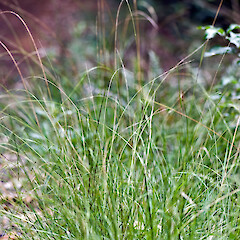Microlaena stipoides
Common name
meadow rice grass, slender rice grass
Synonyms
Ehrharta stipoides Labill.; Microlaena stipoides (Labill.) R.Br. var. stipoides
Family
Poaceae
Flora category
Vascular – Native
Endemic taxon
No
Endemic genus
No
Endemic family
No
Structural class
Grasses
NVS code
The National Vegetation Survey (NVS) Databank is a physical archive and electronic databank containing records of over 94,000 vegetation survey plots - including data from over 19,000 permanent plots. NVS maintains a standard set of species code abbreviations that correspond to standard scientific plant names from the Ngä Tipu o Aotearoa - New Zealand Plants database.
MICSTI
Chromosome number
2n = 48
Current conservation status
The conservation status of all known New Zealand vascular plant taxa at the rank of species and below were reassessed in 2017 using the New Zealand Threat Classification System (NZTCS) – more information about this can be found on the NZTCS website. This report includes a statistical summary and brief notes on changes since 2012 and replaces all previous NZTCS lists for vascular plants.
Please note, threat classifications are often suggested by authors when publications fall between NZTCS assessment periods – an interim threat classification status has not been assessed by the NZTCS panel.
- Conservation status of New Zealand indigenous vascular plants, 2017 . 2018. Peter J. de Lange, Jeremy R. Rolfe, John W. Barkla, Shannel P. Courtney, Paul D. Champion, Leon R. Perrie, Sarah M. Beadel, Kerry A. Ford, Ilse Breitwieser, Ines Schönberger, Rowan Hindmarsh-Walls, Peter B. Heenan and Kate Ladley. Department of Conservation. Source: NZTCS and licensed by DOC for reuse under the Creative Commons Attribution 4.0 International licence.
2017 | Not Threatened | Qualifiers: SO
Previous conservation statuses
2012 | Not Threatened
2009 | Not Threatened
2004 | Not Threatened
Distribution
North Island: throughout. South Island: throughout, less frequent in Canterbury, Otago, and Westland, absent in Fiordland; Stewart Island. Kemadec Islands: Raoul Island. Chatham Islands.
Also indigenous to Australia and Malesia.
There is every reason to believe that Australian races are here as migrants, but it may be impossible to differentiate between them and indigenous plants, however some races appear larger.
Habitat
Open lowland forest and mānuka-kānuka scrub, ruderal and in rough pasture; sea level to 1,300 m.
Wetland plant indicator status rating
Information derived from the revised national wetland plant list prepared to assist councils in delineating and monitoring wetlands (Clarkson et al., 2021 Manaaki Whenua – Landcare Research Contract Report LC3975 for Hawke’s Bay Regional Council). The national plant list categorises plants by the extent to which they are found in wetlands and not ‘drylands’. The indicator status ratings are OBL (obligate wetland), FACW (facultative wetland), FAC (facultative), FACU (facultative upland), and UPL (obligate upland). If you have suggestions for the Wetland Indicator Status Rating, please contact: [Enable JavaScript to view protected content]
FACU: Facultative Upland
Occasionally is a hydrophyte but usually occurs in uplands (non-wetlands).
Detailed description
Rhizomatous perennial with extravaginal branching, and much branched, multinoded stems of many cauline, often stiff hairy leaves, and often purpled spikelets on erectly branched narrow panicles. Branching extravaginal; rhizomes sometimes short; cataphylls chaffy. Leaf-sheath tight, short hairy or glabrous, overlapping node above, keel obscure. Ligule to 0.5 mm, finely erose, ciliate. Auricles 2, small, margin hairs (c. 3 mm) few. Collar short stiff hairy. Leaf-blade 5–25 cm × 2–5 mm wide, abaxially and adaxially abundantly stiff hairy sometimes more so abaxially, midrib prominent; margins with close-set, sharp teeth, retrorse below antrorse above, sometimes thickened, white, undulating. Culm to 85 cm, internodes many, glabrous, sometimes longitudinally grooved. Panicle 10–25 cm, narrow, slender, internodes short, branches erect to 5 cm, > internodes, rachis longitudinally grooved; branches and pedicels finely scabrid. Spikelets 25–35 mm, on slender finely scabrid pedicels; Ø lemmas often purple or purple-suffused. Glumes ± equal, 1-nerved, entire, often purple, margins ciliate, distant from Ø lemmas, < callus hairs; lower to 0.8 mm, upper to 1.5 mm. Callus 1–1.5–2 mm, clothed in hairs to 2 mm. Lower Ø lemma 12–20–30 mm, 5–7-nerved, scabrid, margin short (0.25 mm) hairy, awn > ½ lemma length. Upper Ø lemma 17–26–35 mm, prickle-toothed throughout or glabrous below and prickled above, 5–7-nerved, awn > ½ lemma length; callus hairs 0. ☿ lemma 5–7–9 mm, 5–7-nerved, shining, smooth except for teeth on upper ½ of keel, shortly awned (0.1–1.0 mm) from shortly lobed ciliate apex, margins hyaline; when cleistogamous often included by upper Ø lemma. Palea membranous, hyaline, produced into a mucro or becoming acute, apex ciliate; dimorphic, 4–6–8 mm in chasmogamous flowers, 2–3–4 mm in cleistogamous flowers. Lodicules 2, 1–2–2.7 mm in chasmogamous flowers occasionally hair-tipped, falling with caryopsis; 0 in cleistogamous flowers. Stamens 2–3–4; anthers 1.5–2.5–4.2 mm in chasmogamous flowers, (1)–2–3–4, 0.2–0.4–1.0 mm in cleistogamous flowers. Gynoecium: ovary 0.8–1.2 mm; stigma-styles 1.2–2.5–4.0 mm in chasmogamous flowers, 0.8–1.4–2.0 mm in cleistogamous flowers, stigma branches reaching ovary. Caryopsis laterally compressed, finely wrinkled, often falling free, 3.5–4.5–5.5 mm in chasmogamous flowers, 2–3.8–5.8 in cleistogamous flowers; embryo 0.6-1.0 mm. 2n= 48.
Manaaki Whenua Online Interactive Key
Etymology
microlaena: Small cover (outer scales of spikelet)
stipoides: Like Stipa, another grass
Where To Buy
Occasionally sold by specialist native plant nurseries. However, often present in gardens as a lawn and hedge weed.
Attribution
Fact sheet prepared by Marley Ford (28 December 2021). Brief description, Distribution, Habitat, and Features sections copied from Edgar & Connor (2010).
References and further reading
Edgar E, Connor HE. 2010. Flora of New Zealand. Vol. V. Grasses, 2nd edition. Manaaki Whenua Press, Christchurch, NZ. 650 p.











